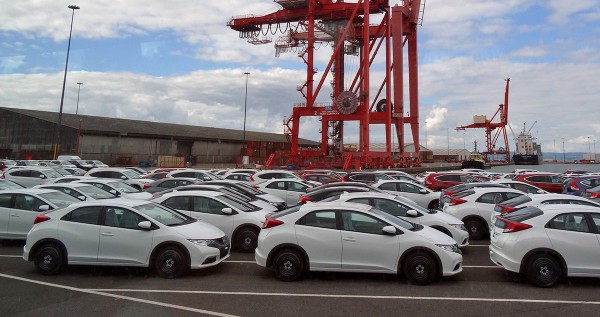 The European Commission has recently carried out a number of investigations into the various sectors of the industry that supplies parts to car manufacturers. Firms have been found guilty of engaging in anti-competitive practices in the supply of bearings, wire harnesses and the foam used in car seats. The latest completed case relates to firms that supply alternators and starters – both important components in a car engine.
The European Commission has recently carried out a number of investigations into the various sectors of the industry that supplies parts to car manufacturers. Firms have been found guilty of engaging in anti-competitive practices in the supply of bearings, wire harnesses and the foam used in car seats. The latest completed case relates to firms that supply alternators and starters – both important components in a car engine.
On January 27th the European Commission announced that it was imposing fines on some Japanese manufacturing companies. Melco (Mitsubishi Electric), Hitachi and Denso were found guilty of participating in a cartel between September 2004 and February 2010 that restricted competition in the supply alternators and starters to car manufacturers.
The Commission gathered evidence showing that senior managers in the three businesses held discussions about how to implement various anti-competitive practices. These either took place on the phone or at meetings in offices/restaurants. In particular the firms agreed:
|
|
| • |
to co-ordinate their responses to tenders issued by car manufacturers. This involved them agreeing on the price each firm would bid. |
| • |
to exchange commercially sensitive information about pricing and marketing strategies. |
| • |
which of them would supply each car manufacturer with alternators and starters. |
These activities are in breach of Article 101 of the Treaty on the Functioning of the European Union (2009). The European Commissioner for Competition, Margrethe Vestager, stated that:
“Today’s decision sanctions three car part producers whose collusion affected component costs for a number of car manufacturers selling cars in Europe, and ultimately European consumers buying them. If European consumers are affected by a cartel, the Commission will investigate it even if the cartel meetings took place outside of Europe”
The fines imposed on the three businesses were as follows:
– Denso €0
– Hitachi €26 860 000
– Melco €110 929 000
How are these fines calculated? When calculating the size of the fine to impose on a firm the Commission takes into account a number of factors. These include:
|
|
| • |
the size of its annual sales affected by the anti-competitive activities. |
| • |
its market share. |
| • |
the geographical area of its sales. |
| • |
how long it had taken part in the cartel. |
| • |
whether it had previously been found guilty of engaging in anti-competitive practices. |
| • |
if it initiated the cartel in the first place i.e. was it the ring leader? |
In this particular case the size of the fine imposed on both Hitachi and Melco was increased because they had both previously been found guilty of breaking EU competition rules.
If a member of the cartel comes forward with information that helps the Commission with its investigation, a reduction in the size of the fine can be applied under a provision called a Leniency Notice (2006). Timing as well as the quality of the information provided influences the size of this reduction. For example, only the first firm to come forward with relevant information can receive a reduction of up to 100% i.e. obtain full immunity. This explains how Denso could be found guilty but not have to pay a fine. (This firm’s initial approach to the Commission actually triggered the investigation.) Any subsequent firms that come forward with information receive smaller fine reductions. Hitachi and Melco received reductions of 30% and 28% respectively.
If a firm accepts the Commission’s decision a further reduction of up to 10% can be applied. This is called a Settlement Notice (2008). All three firms were awarded the full 10% discount in this case.
The European Commission is currently investigating the behaviour of firms that supply car thermal systems, seatbelts and exhaust systems.
Articles
Car parts price-fixing fines for Hitachi and Mitsubishi Electric BBC News 27/01/16
EU antitrust regulators to fine Japanese car part makers: sources Tech News 26/01/16
Mitsubishi Electric and Hitachi get $150 EU cartel fine Bloomberg 27/01/16
EU fines Mitsubishi Electric, Hitachi for car part cartel Reuters 27/1/16
Questions
- What market conditions would make the formation of a cartel more likely?
- Draw a diagram to illustrate the impact of a profit maximising cartel agreement on the price, output and profit in an industry.
- Draw a diagram to illustrate the incentive that each firm has to cheat on an agreed cartel price and output.
- Why did the European Commission introduce Settlement Notices?
 Recent reports in the media have included headlines such as “Sexist surcharge” and “Pink premium?” Various claims have been made that women pay significantly higher prices for similar products than men.
Recent reports in the media have included headlines such as “Sexist surcharge” and “Pink premium?” Various claims have been made that women pay significantly higher prices for similar products than men.
The Times newspaper recently published the results from an investigation it carried out on the prices of hundreds of similar products that were marketed at both men and women. The study found that those products marketed at women cost 37% more on average than similar versions that were marketed at men. Examples included:
- Disposable razors: Tesco priced a packet of five of its own-brand disposable razors for women at £1. The key characteristic that targeted the razors at female customers was the colour – they were pink. For the same price, a packet targeted at male customers (i.e. they were blue) contained 10 disposable razors.
- Ballpoint pens: Staples priced a packet of five pastel-coloured Bic pens marketed ‘for her’ at £2.99. A packet of five Bic pens that were not in the ‘for her’ range (i.e. they had transparent barrels) were priced at £1.98.
- Scooters: Argos increased the price of a child’s scooter by £5 if it was pink instead of blue.
Maria Miller, the chair of the Women and Equalities Select Committee, stated that:
“It is unacceptable that women face higher costs for the same product just because they are targeted at women. Retailers have got to explain why they do this.”
A more detailed study carried out by New York City’s Department of Consumer Affairs was published in December 2015. Average prices were collected for 794 individual items across 5 different industries. The key findings were that products marketed at women were:
- 7 per cent more for toys and accessories
- 4 per cent more for children’s clothing
- 8 per cent more for adult clothing
- 13 per cent more for personal care products
- 8 per cent more for health products
Interestingly whereas the investigation in the UK only found examples of women paying higher prices than men, the New York study found some goods where the price was higher for men.
Reports in the media have claimed that this is clear evidence of price discrimination. Although this is likely to be true, it is impossible to say for certain without more detailed information on costs.
For example, when referring to the higher price for the razors marketed at women in the UK study, Richard Hyman, an analyst at RAH Advisory, stated that:
“the packaging will be different and they will sell fewer so it could be to do with the volume”
If economies of scale and the different costs of packaging can fully account for the difference in prices between the razors then it is not an example of price discrimination.
Articles
Questions
- Define price discrimination.
- Outline and explain the three different categories of price discrimination.
- Could a situation where a firms charges all of its customers the same price for a good or service ever be classed as an example of price discrimination?
- A firm with market power may still not be able to successfully implement a policy of price discrimination. Explain why.
- Under what circumstances could price discrimination improve allocative efficiency?
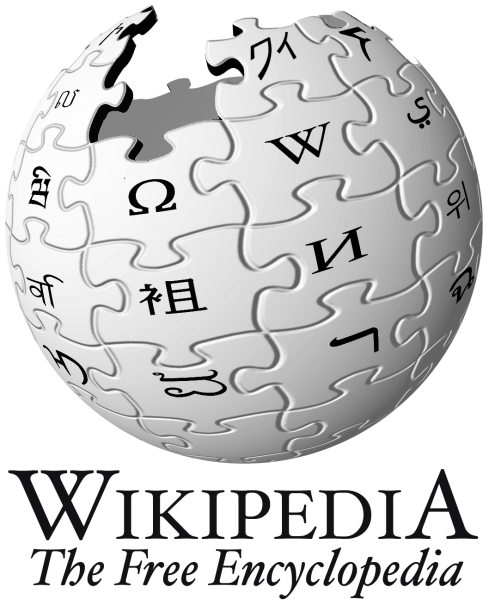 Wikipedia is a free on-line encyclopedia which is compiled and maintained by some of the people who use it regularly. It has been estimated that on any given day 15% of all internet users visit the website. Anyone can write new articles or edit existing material. The encyclopedia has over 5 million entries. So how is it financed?
Wikipedia is a free on-line encyclopedia which is compiled and maintained by some of the people who use it regularly. It has been estimated that on any given day 15% of all internet users visit the website. Anyone can write new articles or edit existing material. The encyclopedia has over 5 million entries. So how is it financed?
If you visit the Wikipedia website at the moment you will be greeted by the following message:
DEAR READERS, We’ll get right to it: This week we ask you to help Wikipedia. To protect our independence, we’ll never run ads. We’re sustained by donations averaging about £10. Only a tiny portion of our readers give. If everyone reading this right now gave £2, our fundraiser would be done within an hour. That’s right, the price of a cup of coffee is all we need. We’re non-profit with costs of a top website: servers, staff and programs. We believe everyone should have access to free knowledge, without restriction or limitation. If Wiki We believe everyone should have access to free knowledge, without restriction or limitation. If Wikipedia is useful to you, please take one minute to keep our work going another year. Thank you.pedia is useful to you, please take one minute to keep our work going another year. Thank you.
Wikipedia Foundation, the not-for-profit company that manages the Wikipedia website, has been running these donation drives for a number of years. The 2014/15 financial year was their most successful to date as 4 million donations were made by people from all over the world.  A total of $75 million was raised compared with $15 million in 2009/10. Although the average contribution was $15.20 in 2014/15, some people contributed over $250,000!
A total of $75 million was raised compared with $15 million in 2009/10. Although the average contribution was $15.20 in 2014/15, some people contributed over $250,000!
Many of you studying economics might find these figures surprising as Wikipedia would appear to have some of the characteristics associated with public goods. On the one hand, the material is perfectly non-rival. If someone decides to read an entry on Wikipedia it does not prevent other users from being able to read the same article. The article does not get used up or depleted in the act of being read. On the other hand, however, it is possible to exclude non-payers from gaining access to the material. For example in June 2010, the Times and Sunday Times introduced a subscription service for access to on-line versions of the newspapers. The New York Times recently announced that it had one million digital subscribers. However given its non-rivalrous nature, material could be shared between payers and non-payers. Groups of people could even get together and share one subscription.
The statement provided by Wikipedia clearly expresses the importance it attaches to free access. Given that it is non-rivalrous in consumption and free of charge to all users, does economic theory predict that people will (i) make voluntary monetary donations (ii) contribute and edit the on-line entries?
If all users are driven by narrowly self-interested preferences and act in a rational manner, then they will not pay and no donations will be made. People will choose to free ride as they can read exactly the same material whether they have paid for it or not.
Given the results of the fund-raising drive are so at odds with this prediction, it suggests that a significant number of Wikipedia users have either altruistic preferences and/or respond to social norms.
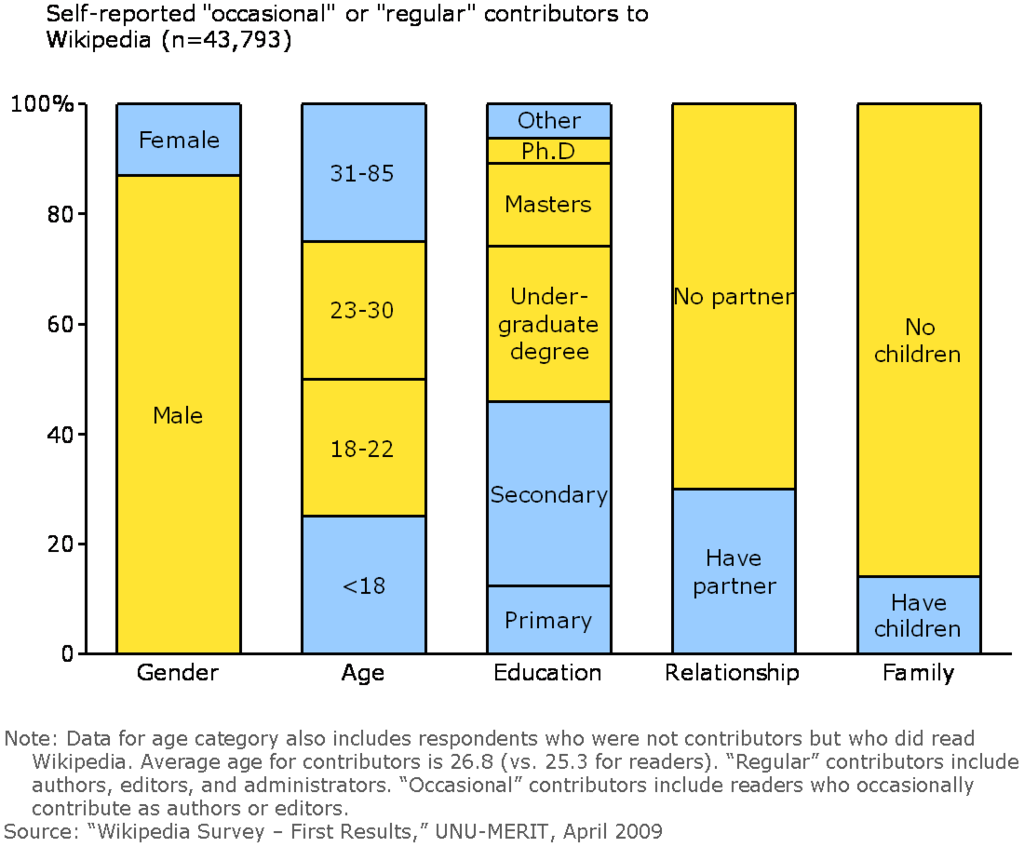 If a rational self-interested person receives no monetary payment for writing or editing an entry would they ever contribute to the website? Given the effort involved it would seem highly unlikely. However the Wikipedia website claims that over 125,000 people contribute regularly. They are referred to as ‘Wikipedians’.
If a rational self-interested person receives no monetary payment for writing or editing an entry would they ever contribute to the website? Given the effort involved it would seem highly unlikely. However the Wikipedia website claims that over 125,000 people contribute regularly. They are referred to as ‘Wikipedians’.
One possible explanation for this behaviour is that some individuals gain utility/pleasure from other people reading and finding their entries both useful and interesting. This utility might increase with the number of potential readers. Therefore keeping access free is a motivating factor for a number of contributors as it maximises the potential readership of their entries. However, the number of contributors fell by a one third between 2007 and 2014.
An interesting question is whether the quantity and quality of contributions would increase if Wikipedia implemented a subscription service which generated enough revenue to enable contributors to be paid but also significantly reduced the number of users.
An alternative way of generating revenue would be to allow advertisements on the website while keeping access free of charge. This option has been resisted so far.
Articles
The Wikipedia fundraising banner sad but untrue Wikipediocracy, The Masked Maggot and friends (11/12/2014)
Newsonomics:10 numbers on the New York times 1 million digital-subscriber milestone Nieman. Ken Doctor (6/8/2015)
The trouble with “Free Riding” Freedom to tinker, Timothy B. Lee (24/8/2008)
The future of Wikipedia: Wikipeaks? The Economist (1/3/2014)
Wikimedia publications
Fundraising report 2014-2015 Wikimedia foundation (26/10/2015)
Wikipedia community
Questions
- How do economists classify goods or services that have a low degree of rivalry but where it is relatively easy to exclude non-payers? Give some real world examples to illustrate your answer.
- How do economists classify goods and services that have a high degree of rivalry but where it is relatively difficult to exclude non-payers? Give some real world example to illustrate your answer.
- Explain why an economically rational individual might still make a donation towards the running of the Wikipedia website.
- Why do you think the number of contibutors has fallen?
- People often complain that Wikipedia entrees are badly written and contain numerous mistakes. To what extent do you think that paying contributors would help to overcome this problem?
- What are the possible advantages/disadvantages of financing Wikipedia by using advertising revenue?
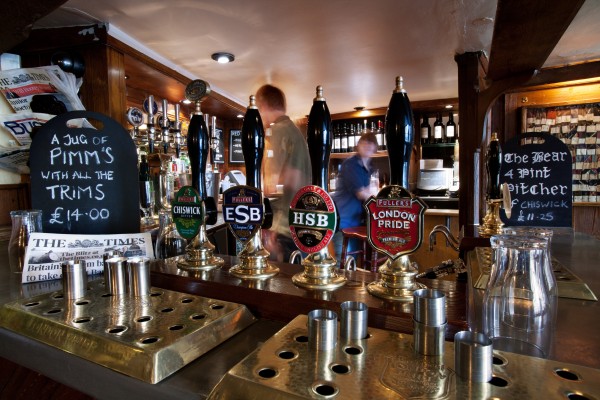 Pubs are closing down in the UK at the rate of 29 per week. The total number has fallen from 67,000 in 1982 to approximately 52,000 this year. In response to this decline the government has recently announced some changes to the way the relationship between pub owners and their tenants are regulated.
Pubs are closing down in the UK at the rate of 29 per week. The total number has fallen from 67,000 in 1982 to approximately 52,000 this year. In response to this decline the government has recently announced some changes to the way the relationship between pub owners and their tenants are regulated.
The ownership of pubs in the UK changed dramatically after a report on the beer market was published by the Monopolies and Mergers Commission (MMC) in 1989. When this investigation took place over 75% of the beer in the UK was produced by the six largest brewing businesses (Bass, Allied Lyons, Grand Metropolitan, Whitbread, Scottish and Newcastle, Courage) which owned over half the pubs. The nature of the relationship between these breweries and the landlords of the pubs they owned caused the greatest concerns.
Some pubs are run as managed houses. In this type of business relationship the person who manages and runs the pub (the publican) is a direct employee of the brewery. However, in many instances this is not the case. Instead they are independent entrepreneurs who enter into a tenancy agreement with the owner of the pub. In other words they rent the pub from the brewery and have some freedom over the way it is run including the setting of prices.
These arrangements have proved to be very controversial because of one particular aspect of many of the tenancy agreements – the exclusive supply contract. Known as the ‘tied lease model’, ‘beer tie’ or ‘wet rent’, it significantly reduces the freedom of publicans to run the business, as they have to purchase almost all their beverages from the brewery that owns the pub.
The MMC report in 1989 concluded that a significant reason for the increasing real price of beer was the market power exerted by the brewers through the tied lease model. It recommended that the number of pubs owned and operated by the brewers should be substantially reduced. Known as the ‘Beer Orders’, the brewers responded by gradually selling off 14,000 pubs. They also eventually sold the breweries to international rivals and companies such as Whitbread and Bass moved into the retail, leisure and hotel sectors. Whitbread currently owns Costa, Brewers Fayre and Premier Inn hotels while Bass, renamed Intercontinental Hotels Groups, owns both Crown Plaza and Holiday Inn hotels.
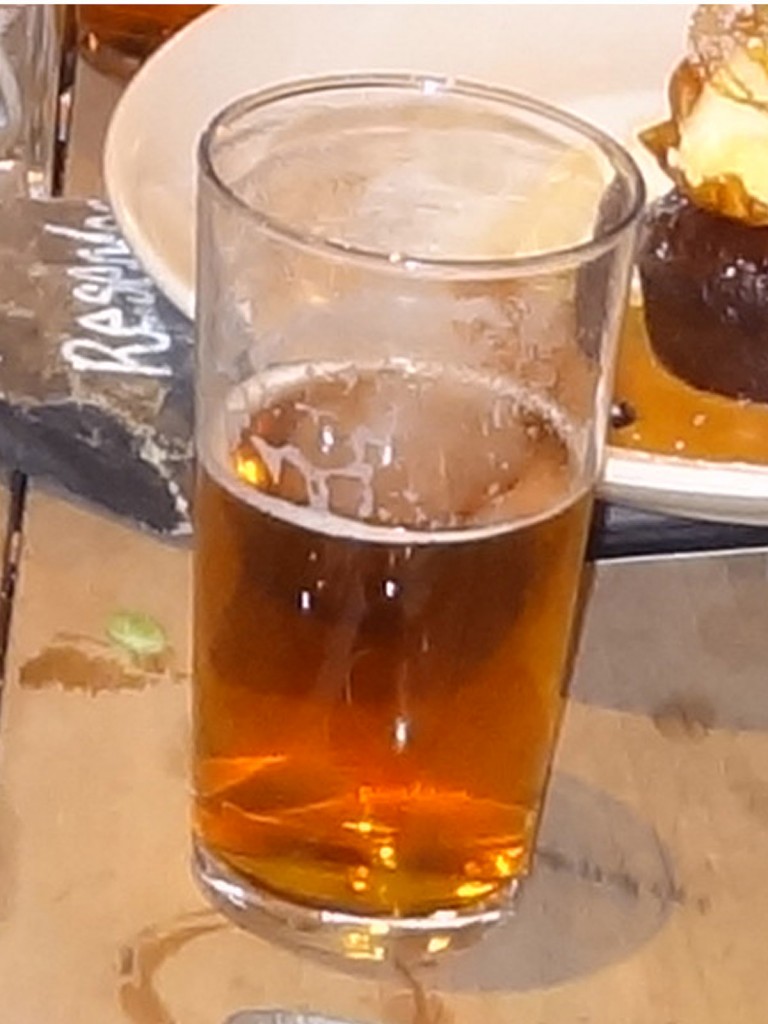 The beer tie between the pubs and the big national breweries might have disappeared but the tied lease arrangement still exists. Instead of being tied to national brewers, many publicans are tied to either smaller regional breweries, such as Everards and Adnams, or another type of business – the pub company known as ‘pubcos’. Some of the larger pubcos include Enterprise Inns, Punch Taverns, Mitchells&Butlers and JD Weatherspoon. They negotiate deals with the breweries and then supply the beer to their pubs.
The beer tie between the pubs and the big national breweries might have disappeared but the tied lease arrangement still exists. Instead of being tied to national brewers, many publicans are tied to either smaller regional breweries, such as Everards and Adnams, or another type of business – the pub company known as ‘pubcos’. Some of the larger pubcos include Enterprise Inns, Punch Taverns, Mitchells&Butlers and JD Weatherspoon. They negotiate deals with the breweries and then supply the beer to their pubs.
In 2014, The British Beer and Pub Association estimated that two-fifths of pubs in the UK were owned by pubcos, while another fifth were owned by regional breweries. In 2013, The Department for Business, Innovation and Skills estimated that 48 per cent of pubs in the UK had landlords who were tied to either a regional brewer or a pub company.
The ownership of pubs may have changed radically over the past 20 years but the tied lease system continues to be extremely controversial. The main argument against the system is that it leads to tied publicans having to pay significantly above free market prices for their beer. The pubcos accept this claim but maintain that, in return for being in a tied lease, the publican pays a lower rent and receives business support services.
Parliament passed the Small Business, Enterprise and Employment Act in March 2015 (see Part 4). This included provisions for the introduction of:
|
|
| • |
a statutory Pubs Code to govern the relationship between the businesses that own the pubs and their tenants; |
| • |
a new independent Adjudicator to enforce the code; |
| • |
a Market Rent Only (MRO) option. |
In October 2015 the government announced some proposals for how the MRO option could be implemented as part of its consultation process with the industry. These include giving the tied publican the right to ask for a rent assessment every five years or whenever the owner of the pub significantly changes the beer prices it charges the tenant. As part of this rent assessment the publican can take the option to switch to an MRO contract. This gives them the freedom to purchase beer from any supplier rather than being tied to those supplied by the owner of the pub.
Enterprise Inns, the largest pubco, operates nearly all of its pubs on the tied lease model. In response to the changes proposed by the Government, the company has announced plans significantly to increase the number of its directly managed pubs from just 16 to 800.
Could the tied lease system finally be about to end?
Articles
Enterprise Inns to grow pub numbers after death of the ‘beer tie’ The Telegraph, Ben Martin, and Peter Spence (12/05/15)
What is the ‘beer tie’ The Telegraph, Denise Roland (19/11/14)
Q&A: Calling time on the beer tie BBC News, Katie Hope (19/11/14)
Chin chin! Fair deal for pub tenants under a new beer tie crackdown City AM, Suzie Neuwirth (29/10/15)
Industry Reacts to New Statutory Pubs Code Eat Out, Nathan Pearce (29/10/15)
What does new pub code mean for the leased pubs? Burton Mail, Andrew Musgrove (04/11/15)
Questions
- What has happened to the big six national brewers which once dominated the beer industry in the UK?
- What factors have caused the decline in the number of pubs?
- Using a diagram, illustrate the impact that the market power of the pubcos might have on the prices paid by publicans in a tied lease.
- Discuss some of the potential advantages of the tied lease model.
- The global brewers and pubcos might create a situation where market power exists in successive stages of the vertical supply chain. Analyse some of the potential implications of this structure and discuss the concept of double marginalisation.
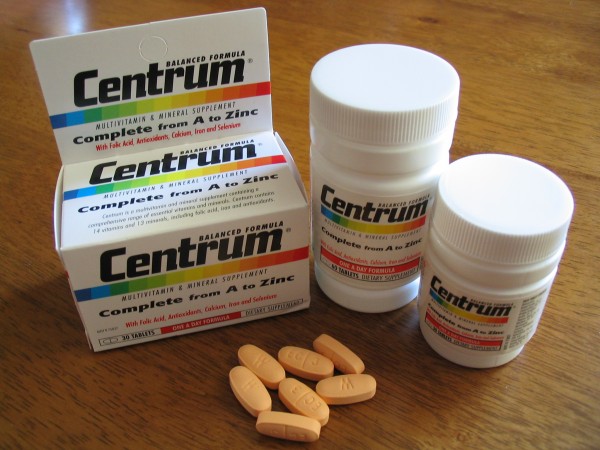 On Monday 23rd November, the US based pharmaceutical business Pfizer (producer of Viagra) announced that it had reached a $160 billion deal to acquire the Irish based pharmaceutical business Allergan (producer of Botox). If it is successful it will be the third largest deal in takeover history.
On Monday 23rd November, the US based pharmaceutical business Pfizer (producer of Viagra) announced that it had reached a $160 billion deal to acquire the Irish based pharmaceutical business Allergan (producer of Botox). If it is successful it will be the third largest deal in takeover history.
In a previous blog on this website a number of reasons were discussed to explain why businesses may engage in mergers and acquisitions (M&As) Are large mergers and acquisitions in the interests of the consumer . These include market power, access to growing markets, economies of scale and reducing x-inefficiency. One of the interesting things about the Pfizer and Allegan deal is the importance of another factor that was not discussed in the article – tax avoidance.
Rates of corporation tax vary considerably between countries and may deter some businesses from operating in the US where it is at the relatively high level of 35%. This compares with a rate of 20% in the UK, 12.5% in Ireland and 0% in Bermuda. The global average rate is 23.7% whereas the average across EU countries is 22.2%.
However, a far bigger incentive for a US firm to merge with or acquire businesses in other countries is the unusual way the US authorities tax profits. Most countries use a territorial system. This means that tax is only paid on the profit earned in that country. For example if a UK multinational business has subsidiaries in other countries it only pays corporation tax in the UK on profits earned in the UK. The profits earned by its subsidiary businesses would be taxed at the rate set by the government in the country where they were located.
The US authorities use a worldwide system. This means that profits earned by a subsidiary in another country are also taxed in the US. This is best explained with the help of a simple numerical example.
Assume a US multinational earns $100,000 in profits from a subsidiary based in Ireland. These profits will be taxed in Ireland at the rate of 12.5% and the company would have to pay $12,500 to the Irish government. If that profit was returned to the US it would be taxed again at a rate of 22.5%: i.e. 35% – 12.5%. The company would have to pay the US authorities $22,500.The worldwide system means that the total rate of tax paid by the firm is 35% but it is split between two different countries. If the territorial system was used, the firm would only pay the $12,500 to the Irish government.
So how could M&As change things? If an M&A enables a US multinational business to change its country of incorporation (i.e. move the address of its headquarters) from the US to another country that operates a territorial system its payments will fall. This is sometimes referred to as tax inversion. As the Bloomberg columnist Matt Levine stated:
If we’re incorporated in the U.S., we’ll pay 35 percent taxes on our income in the U.S. and Canada and Mexico and Ireland and Bermuda and the Cayman Islands, but if we’re incorporated in Canada, we’ll pay 35 percent on our income in the U.S. but 15 percent in Canada and 30 percent in Mexico and 12.5 percent in Ireland and zero percent in Bermuda and zero percent in the Cayman Islands.
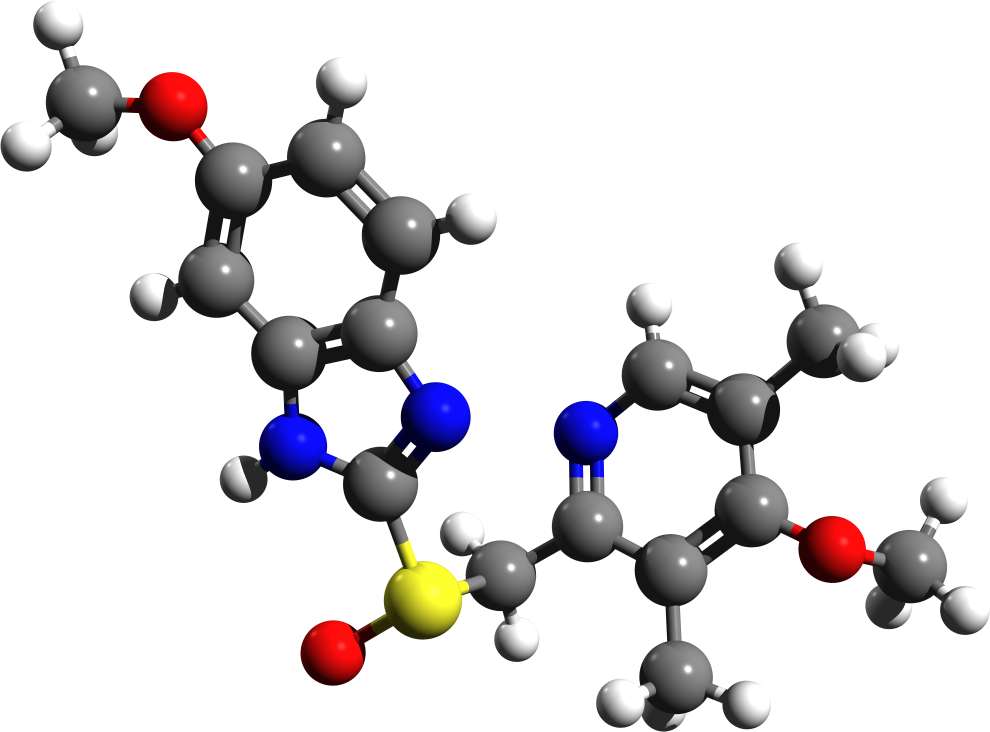 As a result of the merger with Allergan, Pfizer will move the address of its headquarters to Ireland even though its global operations and executives will still be based in New York. It has been estimated that this will generate a one off tax saving of $21 billion as Pfizer would avoid having to pay US taxes on $128 billion of profits generated by its non US subsidiaries.
As a result of the merger with Allergan, Pfizer will move the address of its headquarters to Ireland even though its global operations and executives will still be based in New York. It has been estimated that this will generate a one off tax saving of $21 billion as Pfizer would avoid having to pay US taxes on $128 billion of profits generated by its non US subsidiaries.
A number of US politicians have condemned the proposed deal. For example Hilary Clinton stated:
This proposed merger, and so called inversions by other companies, will leave US taxpayers holding the bag.
Twenty US companies have moved their headquarters to countries that operate a territorial system of taxation since 2012. These include Burger King’s move to Canada and Medtronic’s move to Ireland.
The US government has tried to tighten the rules but the two major parties disagree about how to deal with the problem.
Articles
Pfizer Seals $160bn Allergan deal to create drugs giant BBC News,(23/11/15)
Pfizer’s $160bn Allergan deal under pressure in the US BBC News,(24/11/15)
Pfizer set to buy Allergan in $150bn historic deal The Telegraph,(23/11/15)
Pfizer and Allergan poised to announce history’s biggest healthcare merger-corporate-tax The Guardian,(22/11/15)
Pfizer takeover: what is a tax inversion deal and why are they so controversial? The Guardian,(23/11/15)
Questions
- The newly merged business would jump above Johnson and Johnson to become the world’s largest biotech and pharmaceutical company in the world. Who are the other biggest eight Biotech and pharmaceutical businesses in the world?
- What exactly is a subsidiary? Give some real-world examples.
- How have the US authorities changed the rules in an attempt to deter tax inversions?
- Assume that a US multinational makes $1 million profit in the US and $1 million profit from its subsidiary in Ireland. Explain how changing its country of incorporation from the US to Ireland will alter the amount of corporation tax that it has to pay.
 The European Commission has recently carried out a number of investigations into the various sectors of the industry that supplies parts to car manufacturers. Firms have been found guilty of engaging in anti-competitive practices in the supply of bearings, wire harnesses and the foam used in car seats. The latest completed case relates to firms that supply alternators and starters – both important components in a car engine.
The European Commission has recently carried out a number of investigations into the various sectors of the industry that supplies parts to car manufacturers. Firms have been found guilty of engaging in anti-competitive practices in the supply of bearings, wire harnesses and the foam used in car seats. The latest completed case relates to firms that supply alternators and starters – both important components in a car engine. 






